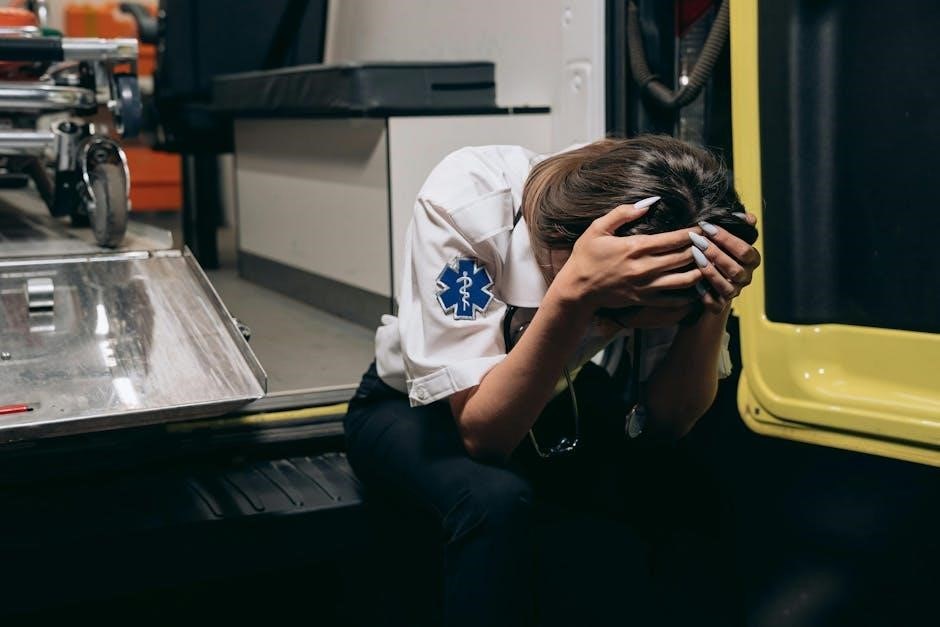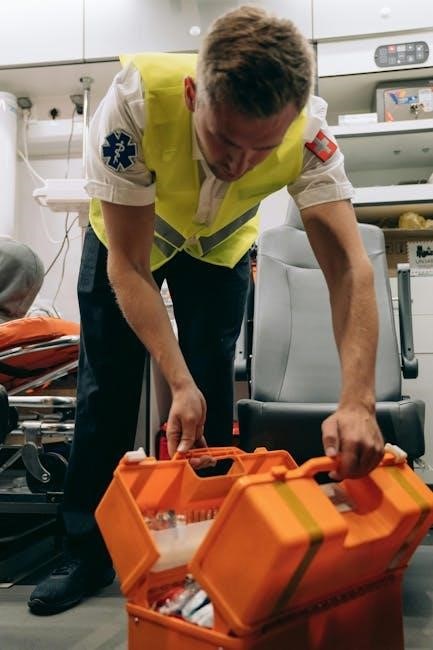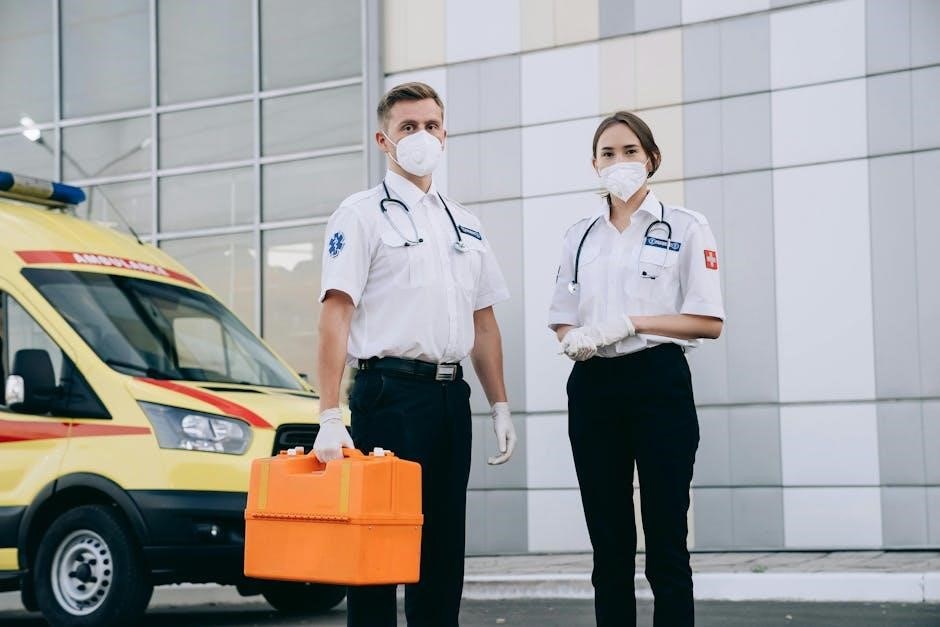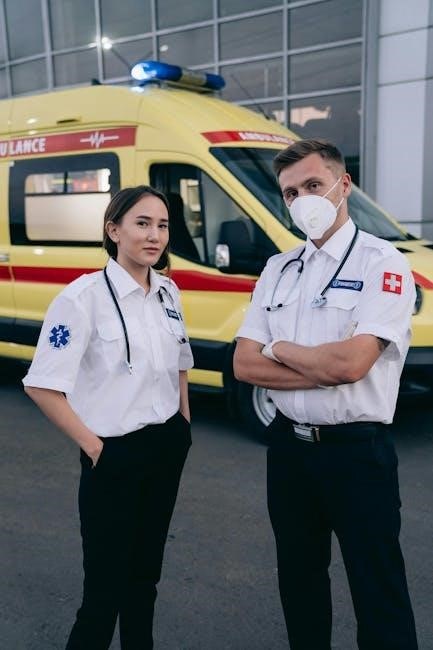A standard ambulance is designed to ensure patient safety, comfort, and efficient emergency care․ It includes essential medical equipment, ergonomic layouts, and compliance with safety standards to minimize injury risks and optimize treatment during transport․
1․1 Overview of Ambulance Design and Purpose
A standard ambulance is a specially equipped vehicle designed for emergency medical care and transportation․ Its purpose is to provide a safe, efficient environment for patient treatment and transport, featuring a patient compartment, essential medical tools, and safety elements like reflective markings and warning systems․
1․2 Importance of Standardization in Ambulance Construction
Standardization ensures ambulances meet uniform safety, design, and performance criteria, reducing risks and enhancing patient care․ It guarantees consistency in equipment, layout, and functionality, facilitating efficient operation and maintenance, while also ensuring compliance with legal and regulatory requirements across regions․
Key Design and Safety Features
Ambulances are designed with safety and functionality in mind, featuring ergonomic layouts, robust construction, and advanced safety systems to protect patients and staff during emergencies․
2․1 Vehicle Dimensions and Layout
Standard ambulances have specific dimensions, with lengths ranging from 14 to 17 feet and headroom between 68 to 74 inches, ensuring adequate space for equipment and patient care while maintaining maneuverability and safety․
2․2 Ergonomic Considerations for Patient and Staff Safety
Standard ambulances prioritize ergonomic design to reduce manual handling and minimize musculoskeletal risks for staff․ The layout ensures easy access to medical equipment, promoting efficient patient care while preventing further injury aggravation during transport․
2․3 Compliance with Federal Motor Vehicle Safety Standards (FMVSS)
Ambulances must comply with FMVSS regulations, ensuring vehicle safety and reliability․ These standards cover critical aspects such as crashworthiness, lighting, and braking systems, thereby protecting both patients and crew during emergency operations and maintaining operational efficiency under all conditions․

Medical Equipment and Functional Requirements
Standard ambulances are equipped with essential medical devices, including defibrillators, ventilators, and stretcher systems, ensuring accessibility for quick patient treatment and monitoring during transport․
3․1 Essential Medical Devices and Tools
Standard ambulances are equipped with vital medical devices, including defibrillators, ventilators, and blood pressure monitors․ Essential tools like stretchers, oxygen supply systems, and drug cases ensure efficient patient care and emergency response capabilities during transport․
3․2 Storage and Accessibility of Equipment
Equipment in ambulances is stored in modular compartments for easy access, ensuring critical tools are quickly retrievable․ Secure storage solutions prevent movement during transit, while organized layouts optimize space and reduce delays in emergency situations․
3․3 Communication and Navigation Systems
Modern ambulances are equipped with advanced communication systems, including two-way radios, antennas, and ground planes, ensuring reliable connectivity․ Navigation tools like GPS enhance route efficiency, enabling faster response times and accurate patient location identification during emergencies․
Exterior Features for Visibility and Safety
Exterior features enhance visibility and safety through high-intensity lighting, reflective markings, and warning systems․ These elements ensure the ambulance is easily noticed, reducing accident risks during emergencies․
4․1 Lighting and Reflective Markings
Standard ambulances feature high-intensity LED strobe lights, warning lamps, and reflective decals to enhance visibility and safety․ These elements ensure the vehicle is easily noticed in various conditions, especially in low-light environments and heavy traffic, reducing accident risks during emergency operations and ensuring timely patient transport․
4․2 Warning Systems and Sirens
Standard ambulances are equipped with advanced warning systems, including dual-tone sirens and public address systems, to alert other road users․ These systems ensure clear communication and visibility, enabling safe navigation through traffic while maintaining patient and public safety during emergency responses․
4․3 Vehicle Insulation and Climate Control
Modern ambulances feature robust insulation and advanced climate control systems to maintain a stable internal environment․ This ensures patient comfort and protects sensitive medical equipment from temperature fluctuations, while also reducing external noise for a quieter, more efficient emergency response environment․

Vehicle Performance and Specifications
Ambulances are built with powerful engines, efficient transmissions, and robust chassis to ensure rapid response and reliability․ Specifications include acceleration capabilities, fuel efficiency, and emission compliance, optimizing performance for emergency medical services․
5․1 Engine Power and Transmission
Standard ambulances are equipped with powerful engines, typically ranging from 4 to 8 cylinders, ensuring rapid acceleration and reliability․ Automatic transmissions are standard, optimizing smooth operation during emergencies․ Engines are designed to meet emission standards, balancing performance with environmental efficiency, while providing the necessary power for quick response and patient transport․
5․2 Fuel Efficiency and Emission Standards
Modern ambulances are designed to meet strict emission standards, such as Euro 5 and Euro 6, ensuring reduced environmental impact․ Fuel efficiency is enhanced through optimized engine performance and lightweight materials, while alternative fuel options are considered to comply with regional emission requirements and sustainability goals․
5․3 Speed and Acceleration Capabilities
Ambulances are equipped to achieve speeds of up to 60km/h in 25 seconds, ensuring rapid response times․ Automatic transmissions and optimized engines enhance acceleration, while adhering to emission standards․ This balance of performance and efficiency enables effective emergency response without compromising environmental or safety regulations․
Maintenance and Cleaning Standards
Ambulances require daily inspections, infection control practices, and scheduled servicing to ensure optimal functionality and hygiene․ Compliance with federal standards like FMVSS guarantees safety and reliability in emergency operations․
6․1 Daily Inspection and Maintenance Checklist
A daily inspection ensures all systems, including lighting, sirens, brakes, and medical equipment, are functional․ Checks must comply with federal standards like FMVSS․ Documentation of inspections is crucial, and staff must be trained to address any issues promptly to maintain safety and readiness for emergency responses;
6․2 Infection Control and Sanitation Practices
Ambulances must adhere to strict infection control standards, using anti-bacterial materials and regular disinfection protocols․ Compliance with BS EN ISO 11378-2 ensures surfaces resist soiling and contamination․ Daily cleaning schedules and staff training are essential to maintain a hygienic environment, protecting both patients and crew from infectious risks․
6․3 Scheduled Servicing and Upkeep
Regular maintenance ensures ambulances remain operational and safe․ Scheduled servicing includes engine checks, electrical system inspections, and verification of medical equipment functionality․ Compliance with OEM standards and maintenance logs guarantees reliability, while addressing issues promptly prevents downtime and ensures readiness for emergency responses․

Legal and Regulatory Compliance
Ambulances must comply with federal and state regulations, including FMVSS and national ambulance standards․ Proper registration, certification, and operational licenses ensure legal operation and adherence to safety and patient care requirements․
7․1 Adherence to National Ambulance Standards
National ambulance standards ensure vehicles meet specific design, safety, and performance criteria․ These standards address vehicle dimensions, equipment requirements, and patient compartment layout to guarantee consistency and reliability in emergency medical services, enhancing both patient care and crew safety․
7․2 Registration and Certification Requirements
Registration and certification are mandatory for ambulances to operate legally․ Vehicles must meet federal and state regulations, including safety standards and equipment specifications․ Certification ensures compliance with operational and medical requirements, while registration validates the ambulance’s eligibility for emergency service deployment and insurance coverage․
7․3 Insurance and Operational Licenses
Ambulances must carry adequate insurance to cover accidents, liability, and patient care․ Operational licenses are issued by regulatory bodies, ensuring compliance with safety and medical standards․ These licenses verify that the vehicle and staff meet all legal requirements for providing emergency medical services effectively and safely․
Specialized Features for Emergency Response
Advanced communication systems, optimized patient compartment layouts, and integrated ALS equipment enhance emergency response capabilities, ensuring rapid and effective care during critical situations․
8․1 Emergency Communication Systems
Modern ambulances are equipped with two-way radios, digital communication devices, and GPS navigation․ These systems ensure real-time coordination with dispatch centers, enabling efficient routing and timely emergency response․ They also support seamless communication between paramedics and hospitals, improving patient outcomes and operational efficiency significantly during critical situations․
8․2 Patient Compartment Design and Layout
The patient compartment is ergonomically designed with modular configurations, ensuring ample space for medical equipment and patient care․ Adjustable shelving, secure storage, and easy access to devices enhance efficiency․ The layout prioritizes patient comfort and safety, facilitating prompt emergency response and effective treatment during transport․
8․3 Integration of Advanced Life Support (ALS) Equipment
Ambulances are equipped with ALS tools like cardiac monitors, ventilators, and infusion pumps, enabling paramedics to provide critical care․ These devices are integrated seamlessly, ensuring reliable operation and easy access during emergencies, thus improving patient outcomes and enabling advanced treatment en route to medical facilities․

Future Trends in Ambulance Design
Future ambulances will focus on technology integration, sustainability, and patient-centric designs, enhancing efficiency, reducing environmental impact, and improving care quality through innovative solutions and materials․
9․1 Integration of Technology and Innovation
Future ambulances will incorporate advanced technologies like telemedicine, real-time patient monitoring, and GPS tracking․ Integration of AI and IoT will enhance diagnostics, while electric vehicles and modular designs improve sustainability and customization, ensuring safer and more efficient emergency care․
9․2 Sustainability and Environmental Considerations
Modern ambulances prioritize eco-friendly designs, including hybrid and electric engines, to reduce emissions․ Lightweight materials and energy-efficient systems lower fuel consumption, aligning with global environmental standards and promoting sustainable emergency medical services without compromising performance or patient care;
9․3 Patient-Centric Design Enhancements
Patient-centric designs focus on comfort and accessibility, featuring adjustable stretchers, improved lighting, and noise reduction․ Enhanced compartment layouts ensure easy access to medical equipment, while ergonomic seating and safety restraints prioritize both patient and staff well-being during transport․
Standard ambulance features ensure safety, efficiency, and patient care․ From ergonomic designs to advanced medical equipment, these elements collectively enhance emergency response, patient outcomes, and operational effectiveness․
10․1 Recap of Essential Ambulance Features
Standard ambulances include modular designs, ergonomic layouts, essential medical equipment, and compliance with safety standards․ These features ensure efficient patient care, minimize risks, and optimize emergency response capabilities while adhering to regulatory requirements․
10․2 The Impact of Standardization on Patient Care
Standardization in ambulance design ensures consistency, safety, and efficiency in patient care․ It minimizes risks, reduces manual handling, and ensures compliance with safety regulations, ultimately enhancing the quality of emergency medical services provided to patients during transport․
10․3 Final Thoughts on the Evolution of Ambulance Design
The evolution of ambulance design reflects advancements in technology, patient care, and safety standards․ Modern ambulances integrate innovative features, ergonomic layouts, and sustainable practices, ensuring safer and more efficient patient transport․ This continuous improvement underscores the critical role of standardization in meeting future healthcare demands effectively․
